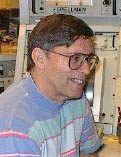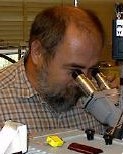Uranium-235 undergoes self-sustaining fission in a nuclear reactor but as uranium also exists in the Earth in great quantities. Japanese geochemist Paul Kuroda predicted that naturally operating nuclear reactors might be possible under special conditions. The special conditions would be a critical mass of uranium with 235U at greater than 2.5%, a high concentration of neutron moderators (such as water and organic compounds) and a low concentration of neutron absorbers. Thankfully, the likelihood of such a natural reactor firing up spontaneously is incredibly remote as the ratio of fissionable uranium-235 to the uranium-238 is only about 0.7%. The ratio of 235 to 238 uranium is extremely uniform throughout the Solar system.
In the past, however, the much shorter half-life of U-235 means that this isotope would have been much more abundant and that ratio much higher. Natural uranium deposits might therefore have achieved critical mass at certain times in the Earth’s history. Other factors such as the presence of water, carbon, and organic compounds would also determine whether such an agglomeration of fissionable uranium would actually undergo a chain reaction as these compounds would moderate, or slow down, the neutrons issuing from the fission reactions to the required speed for fission to take place. On the other hand, iron, potassium, beryllium and gadolinium would absorb neutrons outright and bring the nuclear reaction to a halt.

Charles Hohenberg
In 1972, researchers discovered just such a natural nuclear reactor at the Oklo mine in Gabon, West Africa. There they described a two-billion-year-old uranium deposit some 5-10 metres thick and 600-900 meters wide that had been bathed by an ancient river. The scientists calculated that a deposit of this size may have released 15 gigawatt years, which means it ran at 100 kilowatts for 150 million years.
Now, physicist Alex Meshik and his colleagues, Charles Hohenberg, and Olga Pravdivtseva at Washington University in St. Louis, Missouri, have defined a likely mode of operation for this ancient reactor and confirmed one of the proposed mechanisms of its self regulation. Meshik carried out a microscopic mass spectrometric (MS) examination of the rock samples from the area. He determined the isotopic structure of fission noble gases from samples of uranium-free aluminous hydroxy phosphate containing the fission product La-Ce-Sr-Ca, lanthanum, cerium, strontium, and calcium. He found that these tiny alumophosphate grains found in the material of the ancient reactor preserve a signature of the reactor’s operational mode. It is fascinating that xenon isotopic composition measured today provides us with such pristine timing records for a natural reactor operated two billion years ago, says Meshik.

Olga Pravdivtseva
After the 235U undergoes fission, the radioactive fission products decay into other radioactive nuclei, and finally into stable isotopes, including xenon. The radioactive precursors of xenon are isotopes of iodine, tellurium, tin and antimony, with half-lives ranging from a few seconds to millions of years. Our mass spectrometric analyses of xenon in alumophosphate revealed that the longer the half-life of a radioactive precursor is, the more abundant is the corresponding xenon isotope, explains Meshik, That means that xenon (which is more volatile than its precursors) was lost from alumophosphate when the reactor was hot, and retained there when the temperature dropped. If the temperature was constant the researchers would observe a normal fission spectrum with none of the isotopic anomalies they saw. As the half-lives of all fission products are well known it was not difficult to calculate for how long the temperature was high and how long it took the system to cool down in order to produce the isotopic composition of xenon we measured in our mass spectrometer, adds Meshik.

Alex Meshik
The team’s MS results suggest that the reactor had a cycle lasting a few hours. It would generate heat and boil the overlying water for, typically, thirty minutes. The reduction in water volume would then mean that there was less water to moderate the necessary neutrons for the chain reaction and the reaction would switch off as the majority of neutrons escaped. This stage would last about 2.5 hours.
Meshik and his colleagues have provided an answer to a puzzle that has intrigued physicists since Kuroda first hypothesised such natural nuclear reactors and vexed them even more since the discovery of Oklo – why didn’t the reactor blow up. The boiling off of the overlying water put a lid on the runaway chain reaction. The discovery has more than geological interest, however. The boiling of water points to an alternative means of controlling nuclear power stations. Engineers might also learn lessons about the safe disposal of nuclear waste given that the Oklo reactor is essentially an enclosed system that trapped its own waste over millions of years.
Further reading
Physical Review Letters, 2004, 93, 182302
http://dx.doi.org/10.1103/PhysRevLett.93.182302
Alex Meshik
http://presolar.wustl.edu/people/meshik.html
Charles Hohenberg
http://presolar.wustl.edu/people/Hohenberg.html
Olga Pravdivtseva
http://presolar.wustl.edu/people/Pravdivtseva.html
Biography of Paul Kuroda
http://www.cheg.uark.edu/kuroda/bio.htm
Suggested searches
uranium
nuclear fission
radioactive decay
mass spectrometry